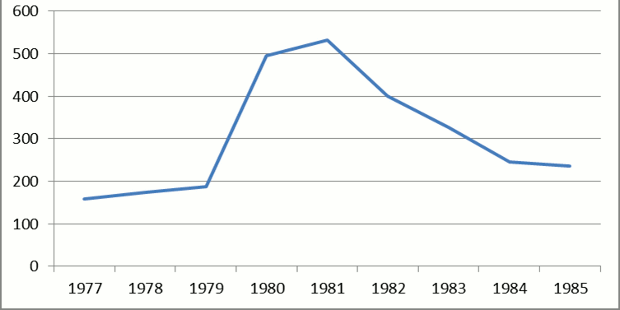
We’re making good progress on our book and, as we leave the nineteen-seventies behind us, we’ve been reading up about the early 1980s UK brewing boom. In interviews with brewers, one theme crops up time and time again, as in this report from 1983: ‘Raising their glasses to success yesterday were three redundant brewery workers and them man who helped them get back into business… Now THEY are the bosses of Britain’s newest brewery — Aston Manor in Birmingham.‘ (Daily Express, 20 May.)
The theme we’re talking about is, of course, redundancy.
At the very start of 1980, Britain officially entered a fifteen month recession. That year saw a huge bump in the number of redundancies, from 187,000 in 1979 to 494,000. Here’s one of those lovely graphs showing redundancies in thousands during this period.

And here’s a graph showing new brewery openings in the same period.

The sources for that last chart are flaky, and we’ve got a lot more research to do into the circumstances behind the founding of the 100 or so new breweries that appeared between 1980 and 1983, but it’s probably not going too far to say that the sudden boom in breweries coincides exactly with the highest peak of redundancies, is it?
On a similar note, and also on our to do list, can it be a coincidence that the most recent boom in brewery numbers occured in the wake of the 2008 global financial crisis?
(We are, by the way, slowly working our way through editions of the CAMRA Good Beer Guide to compile our database of brewery openings by year, which we’ll make available for others to use once its done.)

14 replies on “Recipe for a brewing boom”
“We are, by the way, slowly working our way through editions of the CAMRA Good Beer Guide to compile our database of brewery openings by year, which we’ll make available for others to use once its done”
I think you will find that Quaffale has beaten you to it.
Quaffale is a great resource but their numbers don’t agree with, e.g., Brian Glover’s from 1988, so we’re doomed to have to go back and make our own count, just to be sure. Unless we’re missing something, they don’t make their data available in an easily downloadable format, either, do they…?
You’re quite right – and a user friendly downloadable resoures would be hugely useful and full credit to you guys for putting in the hours to bring it about.
Of course there are always one or two obscure micros that slip through the net. One is the Royal George pub at Lingen in deepest rural Herefordshire that brewed briefly in the 1980s (I was told this by someone who went there at the time). I’ll see if I can unearth anything more about this for you.
Details now sent to you directly. Hope it helps.
Interesting you quote Aston Manor. I have been there – on business – the people are very nice but they never really went for decent beer, ending out doing supermarket white cider for pissheads amongst other stuff. Good business model, rubbish products (IMHO).
Well, they must be nice people, “At Aston Manor, we wholeheartedly support the drinkaware guidelines”. Frosty Jack’s one of theirs isn’t it?
A book? Good God.
(Peers expectantly over half-moon glasses.) Shall we put you down for, say… ten copies?
I know as a fact that the 2008 crisis is to a great extent the engine of the microbrewing boom in Spain, as the 2001-2002 was in Argentina (though, the sharp devaluation of the local currency also played a non-insignificant role)
Interesting. More graphs to follow in the coming weeks, plotting global and UK economic factors against brewery founding dates. Suspect we’ll see a boom after the late 1980s/90s recession, too.
Having recently compiled a catalogue of (hopefully) every current brewer in Wales, I appreciate the difficulty of what you’ve achieved. My sources included the Microbrewers’ Handbook, Quaffale and the Good Beer Guide (the latter for numbers only) and none of their end figures tallied up with mine.
So I wonder if there’s a difference in definition? Does the Good Beer Guide have certain exclusions, eg brewpubs and/or microbreweries?
John — thanks!
Craig — we havent achieved it yet. Still slogging through sources digging out dates and details, such as which consultants/brew kit supplier each brewery used (Bill Urquhart, Peter Austin and Inn Brewing common names so far).
What probably confuses things is:
1. definition of ‘brewery’ — some include homebrew houses/brewpubs, while others don’t
2. definition of ‘new’ — quite a few were relaunches, re-openings or renamings
3. ‘real ale’ status — some (not tons) only sold beer under pressure, or keg beer, so are in some lists but not others.
As for starting dates, you’ve got a choice of company incorporation; when they actually began trading; or their first mention in the press (sometimes the only date there is to go on).
Do you have Ian Mackey’s Twenty Five Years of New British Breweries (from 1998) and its follow-up(s)? Extremely comprehensive …
We do! We’ve also managed to get in touch with Ian who has very kindly given us further information on some of his sources *and* sent us scans of articles from his scrapbooks. (We definitely owe him a pint.)